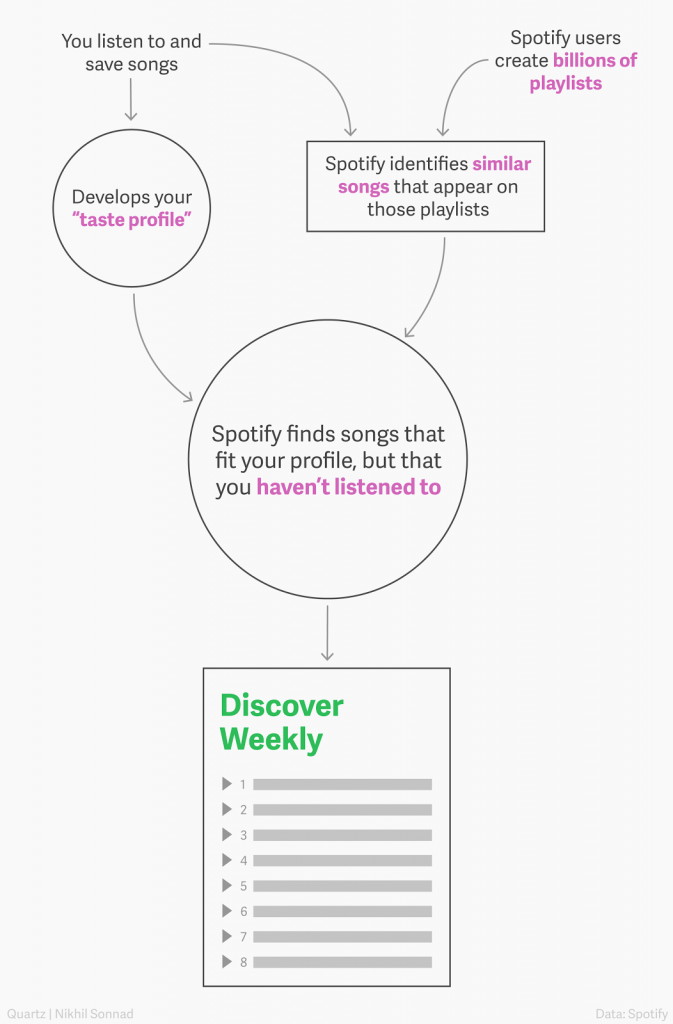The Problem
Recommending music without user data is referred to as the ‘cold-start problem’ and is exactly the problem that Spotify wants to solve. This problem arises because it’s nearly impossible to recommend new and unpopular music because by definition, that type of music lacks usage data to base recommendations off of. Spotify wants to be able to introduce people to bands and songs they’ve never heard.
Spotify’s Algorithm
Spotify uses “Collaborative Filtering” to identify users with similar musical taste in order to recommend new music. Basically, User 1 listens to two Justin Bieber songs, also loves the new single from Justin Timberlake, and stores them all in their “Justin^2” playlist. Then, if User 2 also enjoys the same two Bieber songs, the Collaborative Filtering will recommend the new J.T. single to User 2.
The next step comes from a music analytics startup that Spotify acquired called Echo Nest. The Machine Learning from Echo Nest goes above and beyond matching playlists or preferences. The program reads the articles about music and attempts to quantify the descriptions of new music in a way that allows Spotify to bucket songs and artists, and then recommend them to users. This process (Natural Language Processing) is also used to read the titles of billions of user-generated playlists and categorize the songs by the user-generated titles. Using these buckets from the music press and user playlists, Spotify then creates a “taste profile” or a mix of which categories of music the user most enjoys, and their magnitudes.
Spotify also uses deep-learning on actual audio files. Some attributes of music are easier to find from audio files, like which instruments are used or how fast the beat goes, while other attributes are harder to identify through listening, like genre and age of songs.
These computer generated inputs to the recommendation algorithm are also filtered by some human editorial limits. For example, certain genres like white noise albums are filtered out, and they turn off the Christmas music after…well, Christmas. These guardrails keep the algorithm from making understandable but annoying mistakes.
Effectiveness of Spotify
Spotify’s effectiveness is evidenced by the fact that in March 2017, the company hit 50 million paid subscribers as well as 100 million users. In comparison, Apple Music has 20 million subscribers, Tidal has 3M and Pandora has 4.5M. This indicates that Spotify’s features, including selecting specific songs, downloading music, playlist curation and lack of advertisement has been wooing users to the site and converting them to paid users.
The ability to purchase and afford musical content will continue to challenge Spotify, as it has for Netflix, in order to have music that users want to listen to. This is where Spotify’s “Discover Weekly” or “Daily Mix” can continue to attract users with new music that has lower acquisition costs.
Improving Spotify
While Spotify has an advanced machine learning based algorithm, there may be opportunities to use human-machine interactions to improve the algorithm. They already leverage their human network by identifying early adopters to source their “fresh finds” playlist, and this approach can be expanded more broadly to other curated content across the site. Similar to Pandora, which uses more human sensor input. The musicology team at Pandora developed a list of attributes like “strong harmonies” and “female singer” and human sensors graded these inputs. The limitations of these human sensors are obvious, but Pandora failed when it was unable to transition from radio and recommendations to providing on-demand plays of specific songs.
There is also potential for music video integration in the same vein as YouTube’s new video curated playlists. Spotify could look to pool a library of music videos and pair them with song selections or curate specific video recommended lists based on a newly developed algorithm. There is also the potential to incorporate voice recognition, which has already been piloted by Amazon Unlimited through Alexa. Voice recognition could provide valuable integration with voice recognition software and hardware from Google home to Microsoft’s Cortana for more on demand searches. With many new technology services from voice to video emerging, Spotify has the opportunity to build out unique video and voice experiences within its platform to drive a more extensive music platform for its customers.
Sources:
http://benanne.github.io/2014/08/05/spotify-cnns.html
https://qz.com/571007/the-magic-that-makes-spotifys-discover-weekly-playlists-so-damn-good/
https://www.slideshare.net/MrChrisJohnson/from-idea-to-execution-spotifys-discover-weekly
https://techcrunch.com/2017/03/02/spotify-50-million/
By: Women Communicate Better (Chantelle Pires, Emily Shaw, Kellie Braam, Ngozika Uzoma, David Cramer)

8|